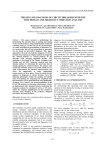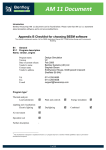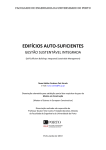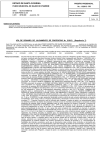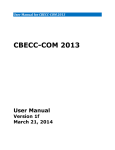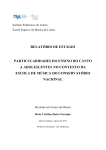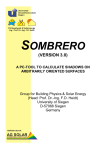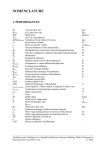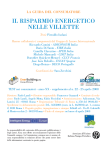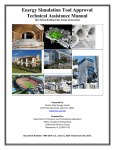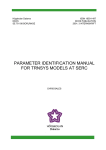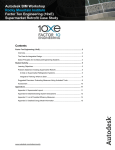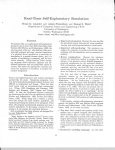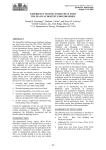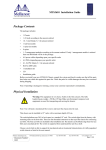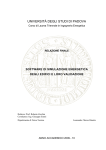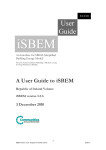Download Open access
Transcript
Performance assessment of heat pump systems in non-residential buildings by means of dedicated simulation models P. André1*, S. Bertagnolio2, P.Y. Franck1 and J.Lebrun2 (1) Environmental Sciences and Management Department University of Liège Arlon Campus BE-014 Arlon, Belgium (2) Thermodynamics Laboratory University of Liège Sart Tilman Campus B49 (P33) Liège, Belgium *corresponding author: [email protected] Keywords: Heat Pump, Reversibility, Heat Recovery, simulation models, IEA – ECBCS Annex 48 1. INTRODUCTION A possibility of increasing interest for reducing the energy consumption in office and health care buildings consist in better exploiting the potential of the heat pump technology. This can be done by recovering heat at the condenser when the chiller is used to produce cold (simultaneous heating and cooling demands) or by using the chiller in heat pump mode (non-simultaneous heating and cooling demands). Of course, when using the chiller in cooling mode, an additional heat source is required to allow heat production. Both strategies appear particularly feasible when the heat pump technology is already, at least partly, present in the building, which is often the case in air-conditioned office buildings. The analysis of these reversibility and recovery potentials is one of the subjects of the IEA-ECBCS Annex 48 project (“Heat pumping and reversible air conditioning”). The aim is to elaborate a package of tools allowing a quick estimation of the potential of both technologies, starting with limited information and using a limited quantity of parameters. In the first part of the paper, the identification methodology is described and the developed simulations tools are briefly presented. In the second part of the paper, the development and the implementation of such models are discussed. Finally, the application of these tools to perform assessment of heat pumping solutions in typical Belgian office buildings are presented and discussed. 2. GENERAL CONCEPT OF IEA 48: CHILLER REVERSIBILITY AND CONDENSER HEAT RECOVERY Most of air-conditioned commercial buildings offer attractive retrofit opportunities, because: 1) When a chiller is used for cold production, the condenser heat can cover (at least) a part of the heating demand; 2) When a chiller is not used for cold production, it can be used in heat pump mode and cover (at least) a part of the heat production. In the frame of the IEA-ECBCS Annex 48 project, several tools are developed for reversibility and recovery potentials evaluation. These tools can be used by decision makers and practitioners to evaluate the energy and economic potential of these solutions for their buildings, using only a limited quantity of data. The first idea of the identification methodology was to start from global information available about the building under analysis: yearly or monthly fuel consumption; yearly or monthly global electricity consumption. From this global information, some indexes can be calculated with the hope to present a good correlation with the energy savings that are possible to achieve. This idea, after testing and validation trials proved not to be sufficiently successful and another approach was carried out. Given the limitations of an estimation based upon global values of heating and cooling demands, it was decided to first generate more detailed information by dynamic simulations. Hourly simulations are carried out using models developed using EES. Hourly values of heating and cooling demands are then used to calculate the reversibility and recovery potentials. The connection with the measurements is done through calibration of the simulation model in order to reproduce the global values. The tools are part of a package of directly executable simulation files including the definition of an evaluation index about reversibility and recovery potentials. Four simulation tools are currently developed. The first two tools, BENCHMARK and SIMAUDIT are developed for audit purposes in the frame of the HARMONAC project. The other tools, SIMZONE, AGGREGATE and GENERATION are developed in the frame of the Annex 48 project to evaluate the heat pumping potential and assess heat pump systems. 3. GENERAL PRESENTATION OF THE SIMULATION TOOLS 3.1 Benchmark The “benchmarking” helps in deciding if it is necessary to launch a complete audit procedure. Usually, it’s based mainly on energy bills and basic calculations. A direct use of such global data would not allow the auditor to identify “good”, “average” and “bad” energy performances. The experimental identification of HVAC consumptions is often almost impossible: these consumptions are, most of the time, not directly measured, but “mixed” with other ones (lighting, appliances etc.). Simulation is then of great help to define some, even very provisory, reference performances (or “benchmarks”), in view of a first qualification of the current building performances. Fig.1: “Benchmark” tool block diagram BENCHMARK (Fig.1) is used to compute the "theoretical" (or « reference ») consumptions of the building, supposed to be equipped with a “typical” HVAC system, including air quality, temperature and humidity control. The building is seen as a unique zone, described by very limited number of parameters. 3.2 SimAudit Global monthly consumptions are often insufficient to allow an accurate understanding of the building’s behavior. Even if some very rough results can be expected from the analysis of monthly fuel consumption, global electricity consumption records analysis do not allow to distinguish the energy consumption related to AC from the consumption related to other electricity consumers. Even if the analysis of the energy bills does not allow identifying with accuracy the different energy consumers present in the system considered, the consumption records can be used to adjust some of the parameter of the simulation models (Fig.2). Some basic data, as building envelope characteristics or the type of HVAC system, are easy to identify, but parameters related to infiltration and ventilation flow rates, operating and occupancy profiles and performances of HVAC components need always to be adjusted. To this end, SIMAUDIT offers a larger range of available HVAC equipment. The building is still seen as a unique zone. The system includes an equivalent global AHU and several types of TU (radiators, fan coils, cooling ceiling, etc.). After having been calibrated to the recorded data, the baseline model can be used to identify the main energy consumers (lights, appliances, fans, pumps …) and to analyze the actual performance of the building. Fig.2: “SimAudit” tool block diagram 3.3 SimZone When having to identify reversibility and heat recovery potentials, it is necessary to be able to identify also and to quantify the simultaneities between heating and cooling demands. This implies to differentiate the building zones presenting different occupancy and operating profiles, HVAC system components, set-points, internal and external loads, etc. By using SIMZONE (Fig.3), the user can simulate the different zones of a building independently. The simulated zone can be a building wing, a storey, a peripheral zone, a core zone of a given storey or a couple of rooms. The main outputs of this simulation work are the heating and cooling demand profiles of each zone. The realism of this simulation is guaranteed by the adjustment of the parameters already realized with SIMAUDIT. Fig.3: “SimZone” and “Aggregate” tools block diagram 3.4 Aggregate The different heating and cooling demand profiles generated with SIMZONE can be aggregated using the Aggregate. This is of course an approximation as this consists in assuming that the demands of each zone are independent of each other. “Reversibility” and “recovery” potentials are then computed by comparing H/C demands profiles as suggested by Stabat1. The reversibility potential depends on the heating power which can be reached when using a chiller in heat pump mode and on the non simultaneous cooling and heating demands. This potential can be calculated hour by hour as the percentage of heating demand which could be provided by a chiller operating in heat pump mode under the following conditions: The “chiller” operates in priority in cooling mode; so reversibility is possible only when no cooling is required; The maximum heating power available is assessed to 0.8 × maximum cooling power of the chiller, the supplementary demand is assumed to be covered by the boiler. The recovery potential depends on the simultaneous heating and cooling demand and on the heat power available on chiller condenser (only consideration on energy recovery for space heating is taken into account here in office buildings, but heat recovery could be also possible for Hot Domestic water and/or humidification). This potential is calculated hour by hour as the percentage of heating demand which could be provided by a chiller condenser under the following conditions: The “chiller” is in operation in order to provide the cooling demand; The maximal heating power available at condenser side is calculated on the basis of energy conservation principle: it corresponds to (EER+1)/EER × cooling power provided by the chiller at the time considered and the supplementary heating demand is assumed to be covered by the boiler. No consideration to emitter temperature levels is done at this stage. 3.5 Generation After having identified reversibility and recovery potentials with help of SimZone and Aggregate, the user has still to select the most interesting heat pump system(s). This selection and the assessment of the selected system(s) can be done by means of a last tool called GENERATION. By using GENERATION (Fig.4), the user may convert the heating and cooling demand profiles in energy consumptions. The main systems presented in deliverable 1.4. (Bertagnolio and Stabat2) are modeled and implemented in a simplified way in order to allow a quick assessment of the selected system(s). GENERATION offers also the possibility to compare the considered system with a more classical production system based on boilers and classical chillers. The hourly (global) values of heating and cooling demands generated by means of SIMZONE/AGGREGATE, or by other simulation softwares (Trnsys, Energyplus…), are used as inputs of the software. The main parameters consist in the characteristics of the chosen system (geothermal system, air-water reversible heat pump, water-water heat pump…) and of the coupled heat source(s)/sink(s) (outdoor air, exhaust ventilation air, ground, underground water, sewage water…). The main outputs of this last tool are: The seasonal and yearly performances of the system (COP, EER, SEER…); the functioning costs (€); the CO2 emissions (kgCO2); primary energy consumptions (kWh); Performance (functioning costs, CO2 emissions, primary energy consumptions) obtained with a classical system composed of air-cooled chiller and boiler. Fig.4: “Generation” tool block diagram 4. MODELS DEVELOPMENT AND IMPLEMENTATION All tools (Bertagnolio and Lebrun3) are developed and implemented in an equation solver (EES, Engineering Equation Solver4). Benchmark, SimAudit and SimZone are developed on the same bases and share the following features: - A dynamic mono-zone building model; - A steady-state HVAC system model, including: Air Handling Units, Terminal Units, plant and distribution system. 4.1 Building zone model The building zone model takes into account the following features: - Envelope and structure dynamic behavior; - Solar gains and infrared losses; - Radiative and convective internal gains (lighting, appliances, occupancy, local heating and cooling devices, ventilation); - Hourly calculation of temperature, relative humidity and CO2 contamination. The dynamic behavior of the building is taken into account by a simplified model to limit the quantity of required data and ensure robustness and transparency. It is based upon a RC network (Fig.5) including five thermal masses, corresponding to a large occupancy zone, surrounded by external glazed and opaque walls. This scheme corresponds to a typical office building, mainly composed of lattice structure and slabs. The R-C model was the object of a comparative validation works carried out using the BESTEST procedure. Fig.5: Building zone model – RC network A sensible heat balance is made on the indoor node to compute the combined convective - radiative indoor temperature. The heat flow emitted by the surfaces of the walls (roof, floor, opaque frontages and windows), the enthalpy flow rate corresponding to ventilation and infiltration air and the internal sensible gains (including local heating/cooling and internal generated gains) are summed (eq. 1), in order to compute the energy storage inside the indoor environment (eq. 3). This energy storage is computed by the means of a first order differential equation. A correction factor (Fa,in ) has to be applied to the air capacity in order to take the effect of the vertical air temperature gradient in the zone into account, as proposed by Lebrun5 and Laret6. dU = Q& roof ,surf ,in + Q& floor ,surf ,in + Q& opaque ,frontages ,surf ,in + Q& windows + H& s ,vent + H& s ,inf + Q& s ,in (1) dτ in τ2 ∆U in = dU ∫ τ dτ 1 dτ (2) in ∆U in = Cin * (t a,in − t a ,in ,1 ) Cin = Fa,in * Vin * ρ a * c p,a (3) (4) Two additional mass balances are used to compute the CO2 concentration and the water content in the indoor environment. The CO2 flow rate entering the zone is due to two main contributions: CO2 brought by ventilation, infiltration and exfiltration air flow rates; CO2 produced by the occupants (function of the occupant metabolic rate). The water flow rate entering the zone is due to three main contributions: Water brought by ventilation, infiltration and exfiltration air flow rates; Water produced by the occupants or local humidification devices; Water condensed by local cooling devices. dM = M& CO 2,vent + M& CO 2,inf + M& CO 2,in dτ CO 2,in (5) dM = M& w ,vent + M& w ,inf + M& w ,in dτ w ,in (6) 4.2 HVAC system model The HVAC model includes the following models (Fig.6): - AHU: at this stage a CAV configuration can be considered, including the following items: fans, heating and cooling coils, humidification systems, filters, recovery and mixing systems - The terminal units can be one of the following types: o radiators o fan coil or induction units o cooling/heating beams o cooling ceiling o floor heating (in course of implementation) - The distribution network concerns both the air and water distribution. - The air distribution network includes: o a rough estimation of the flow rate through a sizing calculation made by the model o selection of the pressure drops by the user - The water distribution network is described by parameters (pressure drops and flow rates) fixed by the user Fig.6: HVAC system scheme – Typical configuration (air cooled chiller and gas boiler) The HVAC plant considers the following energy producers: - Heat production: o gas and oil boilers o condensing boilers o heat pump + heat source - Cool production: o air cooled chiller o water cooled chiller + cooling tower (in course of implementation) Of course, all of these HVAC components have not to be selected at the same time and only the components chosen by the user intervene in the calculation. 4.3 Implementation of the tools Benchmark and SimAudit mainly differ concerning the HVAC system, which is “ideal” in Benchmark (Allowing air quality, humidity and temperature control) and characterized by the following functionalities: Hygienic ventilation rate Humidity Control in AHU Temperature Control by TUs (similar to fan coils) HVAC system parameters are automatically computed trough « sizing calculation » With the same functionalities, SimAudit is able to take into account a larger range of available HVAC components SimZone is based on a similar modeling approach but the application of this tool is restricted to one zone and does not include any distribution network or plant model. When having to deal with a multizone building, it is necessary to successively apply SimZone several times and then to aggregate the different results using the “Aggregate” tool. The implementation of the tools in an equation solver ensures a full transparency for the user and makes easier the continuous improvement and development of the tools. Indeed, model’s equations are directly readable and easy to modify by any user. It is also very easy to develop additional HVAC components models and to connect them to the existing ones. Moreover, the present equation solver is very well adapted to solve differential equations systems as used to model the thermal behaviour of the building zone. Of course, the use of an equation solver to solve complex equation systems implies longer computation time than other simulation softwares, but the continuous increase of computer performances tends to reduce this inconvenience. At present time, about 20 minutes are necessary to simulate a mono-zone building and its complete HVAC system (including AHU, terminal units and heat and cold production and distribution) hour by hour on one year with a classical computer equipped with a 2.00GHz processor. 5. EXAMPLE OF APPLICATION The tools were applied to a typical office building of the Walloon Region of which one floor is shown by Fig. 7. This floor was divided in 5 zones and the heating/cooling demands were calculated for each zone. The results are shown by Fig. 8 and the aggregation of the demands yield the results depicted by Fig. 9. From these hourly evolutions, the reversibility and recovery potentials can be calculated. Fig. 7: Plan view of the building The reversibility and recovery potentials respectively amount to 52% and 13%. These values are in the order of magnitude of what can be expected in our temperate climate with the usual profiles (setpoints, occupancy) of a typical office building. It is anticipated that more interesting values concerning the recovery should be achieved for other types of buildings like hospitals for instance. Zone Temperature/RH profiles Heating/Cooling Demands Central South East Fig. 8: Evolution of the heating and cooling demands of the five zones Fig. 9: Evolution of the aggregated demands of the five zones 6. CONCLUSION In order to assess the potential energy savings obtainable by reconverting a chiller in heat pump or by recovering the heat at the outlet of the condenser, simulation models offer a reliable solution thanks to their ability of taking into account the interaction between the building and the HVAC system. This paper has presented a sequential suite of software tools, all developed using the EES platform and built on a common modeling basis, aiming at, first, quantifying the benefit of such solutions, and then allowing estimating the realistic savings figures to be expected from the application of such strategies. REFERENCES [1] Stabat, P. 2008. IEA-ECBCS Annex 48: Subtask 1: Analysis of heating and cooling demands and equipment performances. Annex 48 project report. [2] Stabat, P., Bertagnolio, S. 2008. IEA-ECBCS Annex 48: Subtask 1.4: Review of heat pumping and heat recovery solutions. Annex 48 project report. [3] Bertagnolio, S., Lebrun, J. 2008. Simulation of a building and its HVAC system with an equation solver: application to benchmarking. Building Simulation: An International Journal. Vol 1, pp.234-250. [4] Klein, S.A. 2008. EES: Engineering Equation Solver, User manual. F-chart software. Madison: University of Wisconsin- Madison, USA. [5] Lebrun J (1978). Etudes expérimentales des regimes transitoires en chambres climatiques. Ajustement des méthodes de calcul. Journées Bilan et Perspectives Génie Civil, INSA Lyon, France. [6] Laret L (1980). Use of general models with a small number of parameters, Part 1: Theoretical analysis. In: Proceedings of Conference Clima 2000, Budapest, 263-276.









